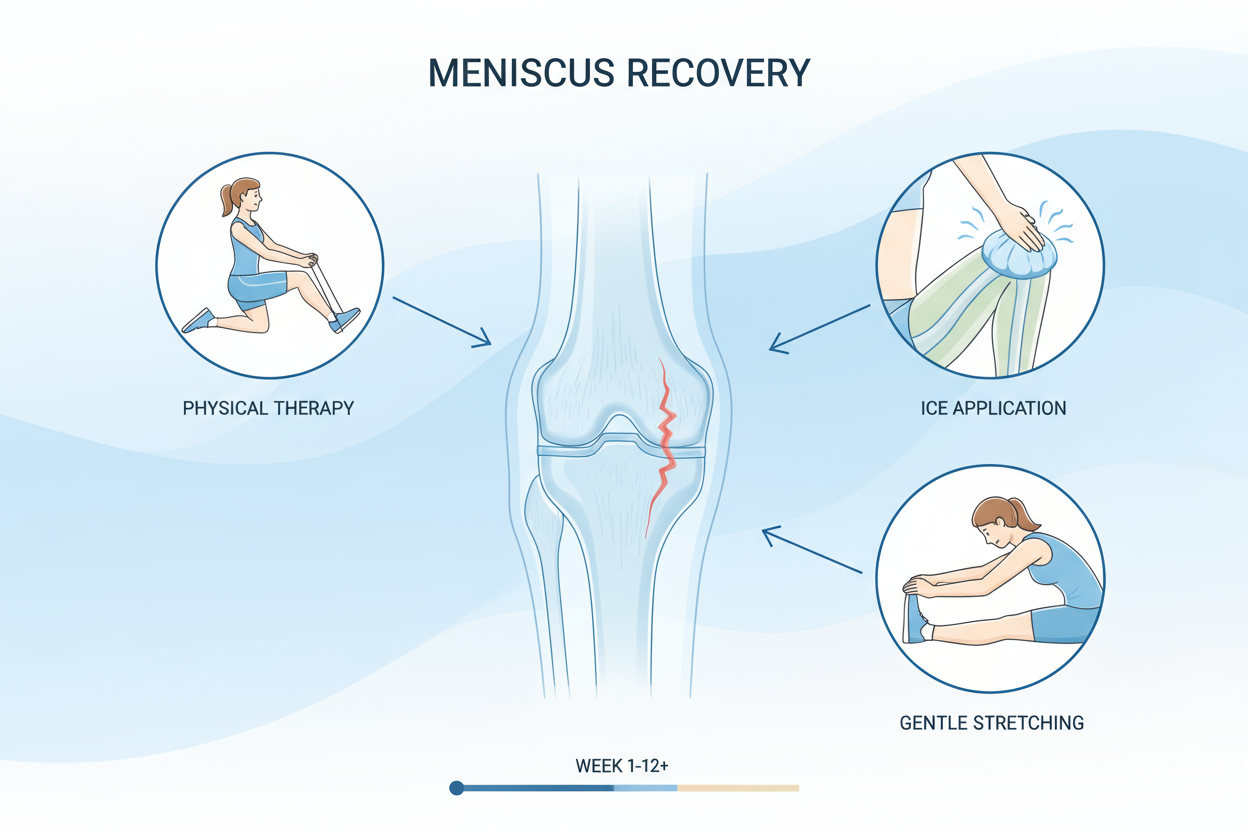Recovering from a Meniscus Tear typically takes 6 weeks to 3 months, depending on the severity of the injury and the chosen treatment plan. Most patients recover through a combination of rest, physical therapy, and proper knee support, while others may require surgery. Using a knee brace or knee support brace during recovery can protect the joint, reduce pain, and accelerate healing by providing stability and support to the knee.
Understanding a Meniscus Tear
The meniscus is a crescent shaped piece of cartilage in the knee joint that acts as a cushion between the thighbone (femur) and shinbone (tibia). When this cartilage tears either due to sports injuries, twisting motions, or gradual wear and tear it causes pain, swelling, stiffness, and limited movement.
Meniscus tears are one of the most common knee injuries, particularly among athletes or individuals engaged in physical work or high impact activity. Depending on the location and severity of the tear, treatment options can range from conservative rehabilitation to surgical repair.
Step 1: Initial Rest and Protection
Immediately after a meniscus tear, the first step in recovery is to protect the knee and minimize further damage. This phase generally lasts for the first 1-2 weeks.
- Rest: Avoid weight-bearing activities and movements that cause pain.
- Ice: Apply ice packs for 15-20 minutes every few hours to reduce swelling.
- Compression: Using a knee brace or knee support helps reduce inflammation and provides stability.
- Elevation: Keep the leg elevated above heart level to minimize swelling.
This combination often referred to as the RICE method (Rest, Ice, Compression, Elevation) is the foundation of early recovery.
Step 2: Use a Knee Support or Knee Brace
A knee support brace is an essential part of the healing process, whether your treatment is surgical or non surgical. It helps by:
- Stabilizing the joint: Preventing unwanted motion that can worsen the tear.
- Providing compression: Reducing swelling and promoting circulation.
- Encouraging confidence: Allowing gradual movement during rehabilitation.
There are several types of knee braces from soft sleeves to hinged braces and your doctor or physiotherapist will recommend the most appropriate one based on your injury’s severity. Wearing it during daily activities or physical therapy sessions can significantly reduce recovery time.
Step 3: Gentle Mobility Exercises
After the pain and swelling subside, light range of motion exercises are introduced. This step usually begins within 1-2 weeks of the injury or post surgery.
Examples of early exercises include:
- Heel slides: Gently sliding the heel back and forth while sitting or lying down.
- Quadriceps sets: Tightening the thigh muscles to maintain strength.
- Straight leg raises: Strengthening the quadriceps without stressing the meniscus.
Always perform these under the supervision of a physical therapist to prevent overexertion or further damage.
Step 4: Physical Therapy and Strength Training
Physical therapy is the core of meniscus tear recovery. A professional therapist designs a personalized plan to restore strength, stability, and mobility.
Typical goals of physical therapy include:
- Regaining full range of motion
- Strengthening supporting muscles (quadriceps, hamstrings, calves)
- Improving balance and coordination
- Preventing future knee injuries
Throughout this process, continued use of a knee support can help protect the joint during workouts and ensure proper alignment.
For non surgical cases, physical therapy often lasts 4-8 weeks, while post surgical rehabilitation can extend up to 3-6 months.
Step 5: Surgical Treatment (If Needed)
Not all meniscus tears heal on their own. Large, complex, or unstable tears may require surgery, such as:
- Meniscus Repair: The torn edges are stitched together to allow healing.
- Partial Meniscectomy: The damaged portion of the meniscus is removed.
Recovery after surgery involves several weeks of limited mobility, during which a knee brace is typically worn to protect the repair. Physical therapy gradually reintroduces movement and strengthens the knee over the following months.
Even after surgery, using a knee support brace can prevent reinjury and ensure long-term joint stability.
Step 6: Gradual Return to Activity
Once the knee has regained strength and flexibility, patients can slowly return to their normal activities. The timeline depends on the treatment type and the individual’s healing progress:
- Non surgical recovery: 6-8 weeks for light activity
- After meniscus repair: 3-6 months before returning to sports or strenuous activity
During this stage:
- Continue to wear your knee brace during exercise or high impact movement.
- Warm up before workouts to reduce stress on the joint.
- Incorporate low impact exercises such as cycling, swimming, or yoga to maintain strength without overloading the knee.
Step 7: Maintain Long Term Knee Health
Even after full recovery, it’s essential to protect your knee from future injuries. Follow these long term strategies:
- Keep muscles strong: Continue strength training for the legs and core.
- Use a knee support brace: Especially during high risk activities or sports.
- Maintain a healthy weight: Reducing body weight decreases stress on the knees.
- Practice good movement patterns: Avoid sudden twisting or pivoting that can strain the meniscus.
- Listen to your body: Pain, stiffness, or swelling after activity signals that your knee needs rest.
Tips for Faster Recovery
- Follow your rehabilitation plan: Consistency is key. Skipping therapy sessions can delay healing.
- Eat a balanced diet: Nutrients like collagen, vitamin C, and omega 3 fatty acids support tissue repair.
- Stay hydrated: Proper hydration aids joint lubrication and recovery.
- Avoid re injury: Don’t return to sports too early wait until your doctor or therapist clears you.
When to See a Doctor
Seek professional medical advice if you experience:
- Persistent or worsening knee pain
- Locking, catching, or instability in the joint
- Swelling that doesn’t improve after rest
- Difficulty walking or bending the knee
A doctor can evaluate whether additional treatment, imaging, or surgery is required. Early intervention often leads to better long term outcomes.
The Role of Patience and Consistency
Recovering from a meniscus tear requires time and discipline. Many patients feel frustrated by the slow progress, but steady improvement through guided exercise, proper knee support, and adequate rest leads to strong, lasting results.
Remember: rushing the process can cause setbacks, while consistent care leads to full recovery and a return to pain-free movement.
Conclusion
Recovering from a Meniscus Tear is achievable through a structured combination of rest, physical therapy, and supportive care. Most people heal within 6 weeks to 3 months, though surgical cases may take longer. Wearing a knee brace throughout the process can provide essential stability, reduce pain, and protect against re injury. With proper guidance, commitment, and patience, you can regain full mobility and return to an active, confident lifestyle.









